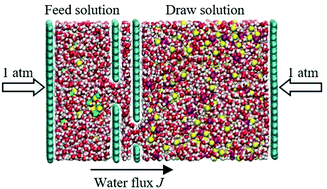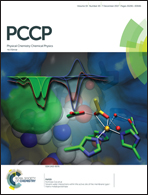Graphene membranes with nanoslits for seawater desalination via forward osmosis
Abstract
Stacked graphene (GE) membranes with cascading nanoslits can be synthesized economically compared to monolayer nanoporous GE membranes, and have potential for molecular separation. This study focuses on investigating the seawater desalination performance of these stacked GE layers as forward osmosis (FO) membranes by using molecular dynamics simulations. The FO performance is evaluated in terms of water flux and salt rejection and is explained by analysing the water density distribution and radial distribution function. The water flow displays an Arrhenius type relation with temperature and the activation energy for the stacked GE membrane is estimated to be 8.02 kJ mol−1, a value much lower than that of commercially available FO membranes. The study reveals that the membrane characteristics including the pore width, offset, interlayer separation distance and number of layers have significant effects on the desalination performance. Unlike monolayer nanoporous GE membranes, at an optimum layer separation distance, the stacked GE membranes with large pore widths and completely misaligned pore configuration can retain complete ion rejection and maintain a high water flux. Findings from the present study are helpful in developing GE-based membranes for seawater desalination via FO.



 Please wait while we load your content...
Please wait while we load your content...